Food and Beverage (F&B) services are the cornerstone of the hospitality industry, shaping memorable dining experiences. From the elegance of table service to the autonomy of self-service, each service style caters to different guest preferences, occasions, and operational needs.
This guide explores the four main types of food and beverage service—Table Service, Assisted Service, Self-Service, and Special Service—along with their key subcategories like English Service, American Service, French Service, and Room Service. You’ll discover their features, advantages, and drawbacks, helping you implement the ideal service style for any setting.
The 4 Main Types of F&B Service:
- Table Service
- Assisted Service
- Self-Service
- Special Service
Get a quick overview of the different types of food and beverage services with this infographic. From table service to self-service, explore the key styles at a glance!

Let’s explore each type and its variations to better understand their impact on the guest experience.
1. Table Service
Table service is a formal style where guests are seated, and the waitstaff takes care of orders, serving, and sometimes tableside preparations. It is known for its personalized attention, refined presentation, and high service standards, making it ideal for fine dining, luxury restaurants, and high-end hospitality establishments.
This service type focuses on presentation, ambience, and professional execution, ensuring a memorable dining experience. Its variations cater to different levels of luxury, interaction, and cultural traditions, offering flexibility across diverse dining settings.
Let’s explore the various styles of table service that offer personalized dining experiences.
1.1 English or Family Service

English Service, also known as Family Service, offers a communal dining experience where food is presented on large platters and placed at the centre of the table. Guests either serve themselves or are served by the host or a waiter, creating a relaxed and interactive atmosphere.
This service style is popular in speciality and celebratory dining, particularly for occasions that encourage longer dining durations and social engagement. It fosters a homely feel, making it ideal for family gatherings, festive events, and private dining experiences.
How It Works:
- Food is brought to the table on large serving platters.
- The host may serve the guests or allow a waiter to assist.
- Guests help themselves, promoting a shared dining experience.
Advantages:
- Encourages social interaction and a warm, family-like setting.
- Ideal for leisurely dining and special occasions.
Disadvantages:
- Service can be slower, especially for larger groups.
- Requires skilled staff to manage large portions while maintaining presentation.
1.2 American or Plate Service
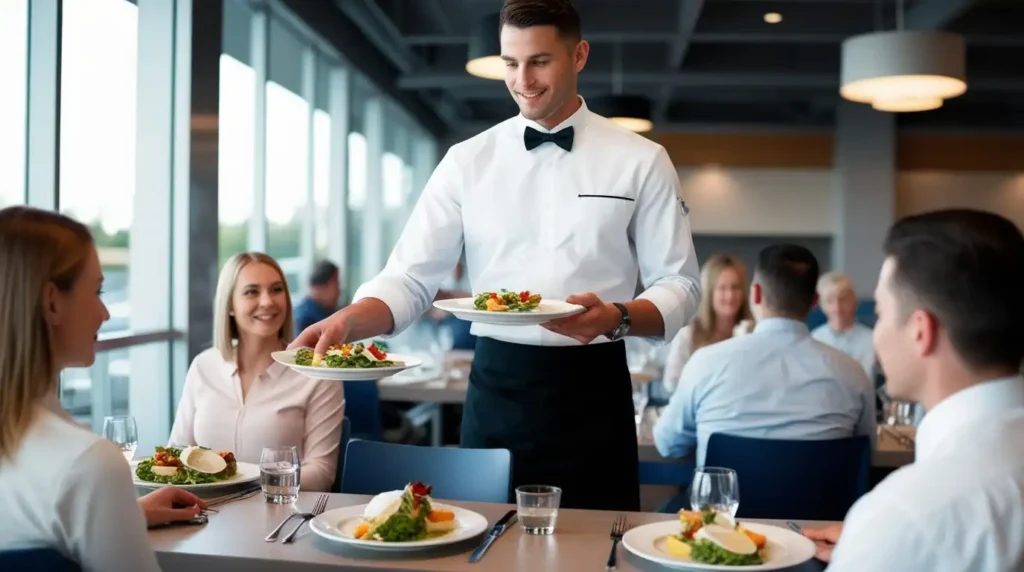
American Service is an efficient and fast-paced dining style where food is pre-plated in the kitchen and served directly to guests. This method ensures consistency in portion size, presentation, and quality, making it a preferred choice for casual dining, chain restaurants, and high-turnover establishments.
Its streamlined approach minimises staff training requirements, as servers focus primarily on delivering food rather than preparing or portioning it tableside.
How It Works:
- The kitchen plates the food with predetermined portions.
- The staff serves the pre-plated meals directly to guests.
- Ensures quick and uniform service, ideal for fast-paced restaurants.
Advantages:
- Maintains consistent portion sizes and presentation.
- Reduces service time, improving efficiency in busy establishments.
Disadvantages:
- Limited guest interaction reduces the personalised experience.
- Offers minimal customisation once the food is plated.
1.3 French Service

French Service is a luxurious and sophisticated dining style that emphasizes elegance, interaction, and theatrical presentation. Food is presented in platters and casseroles, which are placed near guests, allowing them to serve themselves or be served by staff.
There are two main variations:
- Cart French Service (Gueridon Service) – Involves tableside preparation where dishes are finished and served in front of guests.
- Banquet French Service – Used for large gatherings, where pre-plated meals are served efficiently.
This service style is commonly found in VIP events, fine dining restaurants, and high-end banquets, where personalisation and presentation are key.
How It Works:
- Food is beautifully arranged on platters and brought to the dining area.
- Guests can either serve themselves or be served by trained waitstaff.
- In Cart French Service, certain dishes are prepared or finished tableside for added elegance.
Advantages:
- Enhances guest experience with its refined and interactive presentation.
- Allows customisation, as guests can choose portion sizes and preferences.
Disadvantages:
- Time-consuming and requires highly trained staff.
- Higher operational costs due to specialised equipment and service techniques.
For a clear breakdown of the French service style and its formal dining steps, visit What Is French Service Style – Swoogo.
1.4 Gueridon Service
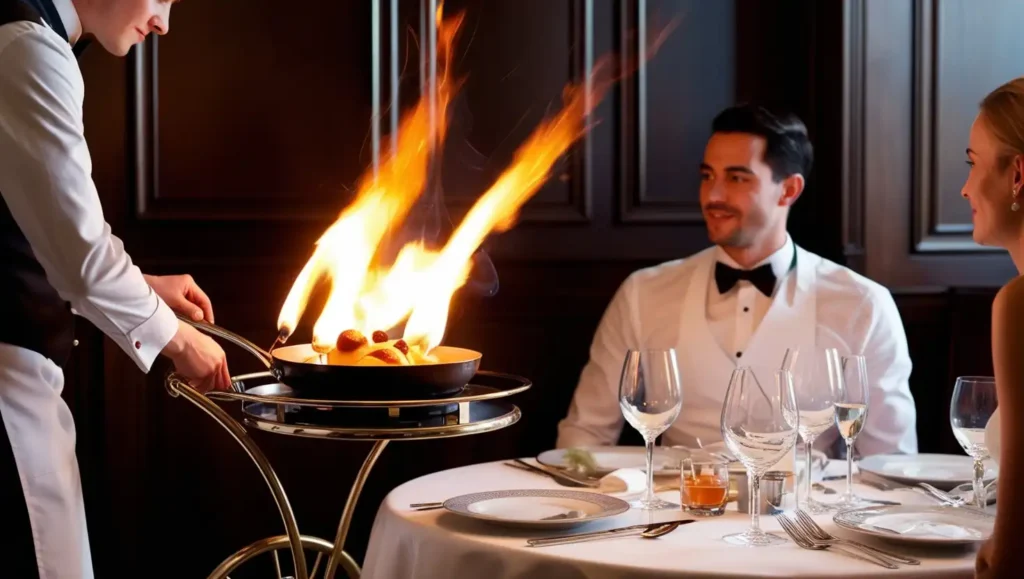
Gueridon Service is a refined and theatrical dining style where partially prepared dishes are finished tableside using a Gueridon trolley. This method enhances the guest experience through showmanship and engagement, making it a hallmark of fine dining and luxury establishments.
It is commonly used for flambé dishes and specialty meals, requiring highly skilled staff who can manage both preparation and presentation with precision.
Read our complete guide on: Gueridon Service in Fine Dining: History, Types, and Techniques
How It Works:
- Food is partially cooked in the kitchen and brought to the dining area.
- A waiter uses a Gueridon trolley to finish cooking or assemble the dish tableside.
- Often includes flambé or carving, adding a dramatic touch to the experience.
Advantages:
- Creates a memorable and interactive dining experience.
- Showcases staff expertise, elevating the meal’s presentation.
Disadvantages:
- Requires highly skilled staff and specialized equipment.
- Challenging to execute in high-volume or fast-paced settings.
1.5 Silver Service

Silver Service is a traditional and sophisticated dining style where food is elegantly presented on silver platters and served to guests using specialised serving spoons and forks. This technique requires precision and skill, making it a hallmark of formal banquets, high-profile events, and luxury dining establishments.
Renowned for its grace and tradition, Silver Service ensures an elevated and refined guest experience, emphasising meticulous presentation and attention to detail.
How It Works:
- Food is arranged on silver platters and brought to the dining table.
- A skilled waiter serves guests individually using spoons and forks, following a precise technique.
- Service is traditionally performed from the left side of the guest.
Advantages:
- Enhances formality and elegance, creating an exclusive dining experience.
- Ideal for prestigious events, fine dining, and luxury hospitality.
Disadvantages:
- Requires highly skilled staff trained in precise serving techniques.
- Higher costs due to the use of silverware and formal service settings.
To explore additional insights like serving techniques, historical context, and formal etiquette of Silver Service, check Silver Service – Wikipedia.
1.6 Russian Service
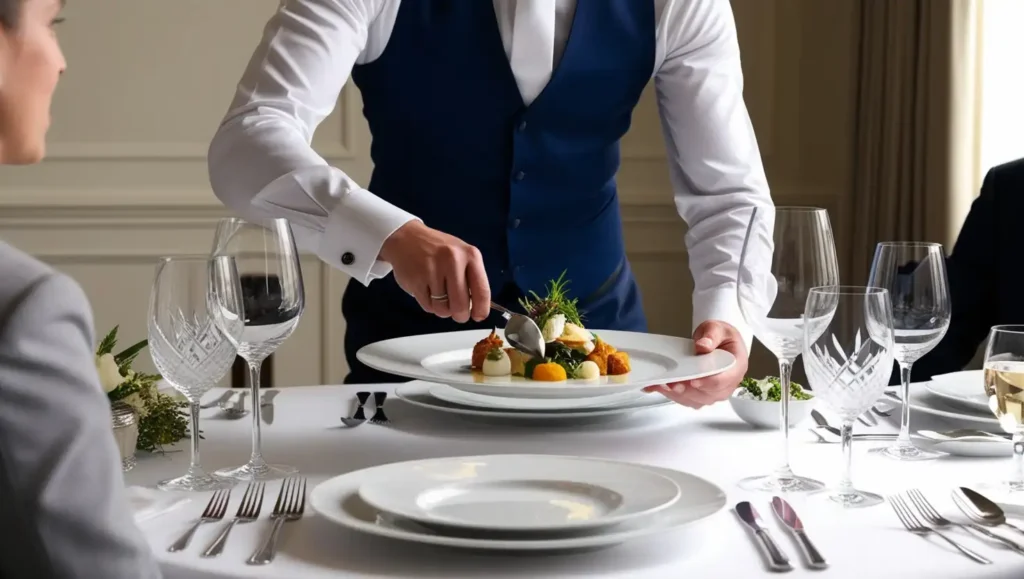
Russian Service is a formal yet efficient dining style where food is presented on large platters and portioned directly onto guests’ plates by a skilled waiter. Similar to Cart French Service, it balances elegance with practicality, making it suitable for upscale banquets and fine dining settings.
This method emphasises precision and presentation, offering a refined yet streamlined service experience.
How It Works:
- Food is pre-plated in the kitchen and brought to the dining area.
- The waiter serves portion-controlled servings directly from elegant platters.
- Service is performed from the left side of the guest.
Advantages:
- Combining formality with efficiency, ensuring a smooth dining experience.
- Ideal for upscale events and banquets that require structured yet elegant service.
Disadvantages:
- Lacks interactive elements found in Gueridon or French Service.
- Requires trained staff to ensure proper serving techniques.
2. Assisted Service
Assisted Service blends self-service with staff support, offering a convenient yet structured dining experience. This style is commonly used in casual dining, events, and hotel buffets, where efficiency is key in serving large groups of guests.
Guests help themselves from counters or buffets, while staff assist by replenishing dishes, providing guidance, or serving specialised items, ensuring a smooth and organised dining flow.
Here are the different assisted service styles that balance self-service with staff support.
2.1 Buffet Service
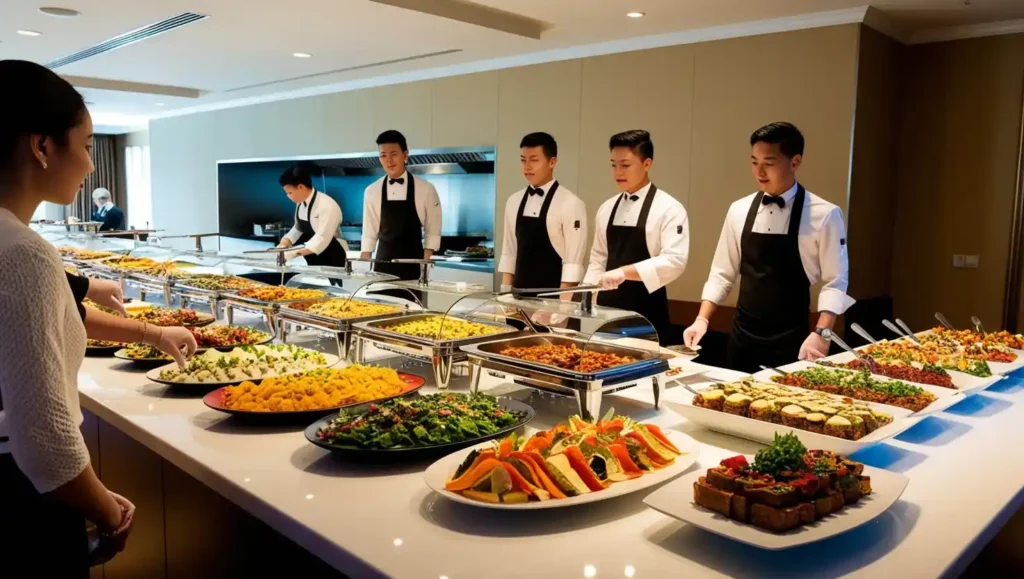
Buffet Service combines self-service with staff assistance, ensuring a smooth and efficient dining experience. A variety of dishes are laid out on buffet counters, allowing guests to serve themselves while waitstaff assists with replenishment and guidance.
This service is widely used in hotels, events, and celebrations, as it efficiently caters to large groups while offering variety and flexibility in meal choices. Sit-down buffets may also feature pre-set tables for added comfort.
How It Works:
- Guests serve themselves from a selection of dishes arranged on buffet counters.
- Staff assist by refilling dishes and maintaining cleanliness.
- Some buffets offer live stations where chefs prepare food on demand.
Advantages:
- Cost-effective for serving large groups.
- Provides variety and flexibility, allowing guests to choose their preferred dishes.
Disadvantages:
- Food wastage is common due to self-service.
- Requires constant replenishment and staff monitoring.
2.2 Cafeteria Service

Cafeteria Service is a fast and efficient dining style where guests queue at a counter to select pre-prepared meals before carrying their trays to a seating area. This service is commonly found in schools, offices, hospitals, and workplace canteens, catering to large groups with limited time.
Focusing on convenience and speed, cafeteria service minimises waiting times and staffing requirements, making it a cost-effective choice for high-traffic environments.
How It Works:
- Guests move in a line along a serving counter, selecting pre-portioned meals.
- Food is often pre-cooked and displayed for quick selection.
- Guests carry their trays to designated seating areas.
Advantages:
- Quick service with minimal wait times.
- Reduces staffing needs, making it cost-effective.
Disadvantages:
- Limited menu options, which may not satisfy all guests.
- Less personalised experience compared to table service.
3. Self-Service
Self-service allows guests to independently select, pay for, and consume their food, minimising staff involvement while maximising efficiency. This style is commonly found in food courts, kiosks, takeaway counters, and quick-service restaurants, catering to fast-paced environments where convenience and speed are priorities.
Ideal for casual dining and high-turnover settings, self-service is a cost-effective option for establishments aiming to reduce operational costs while maintaining efficiency.
Let’s look at the self-service methods that prioritise speed and convenience
3.1 Food Courts
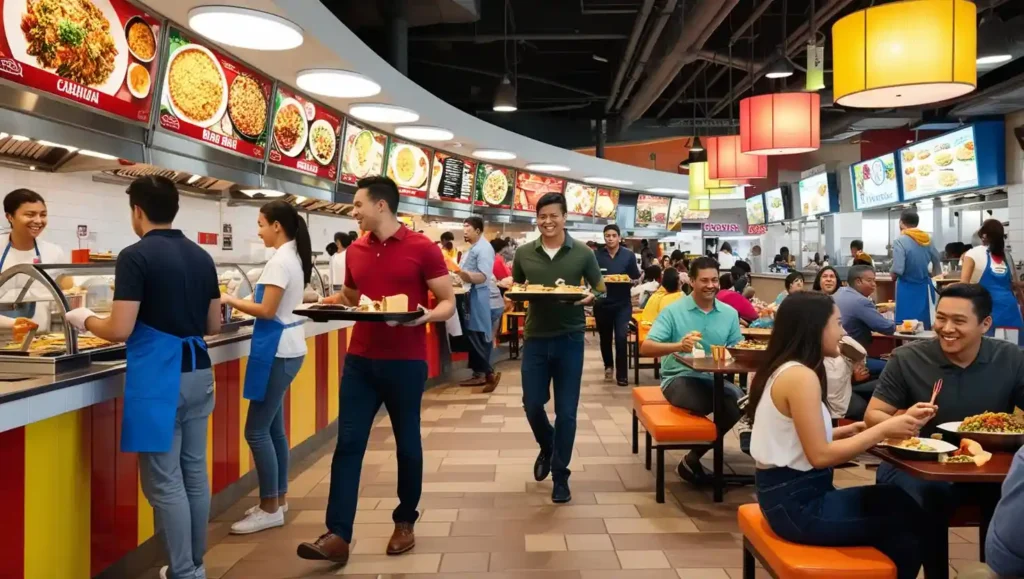
Food Courts are vibrant, multi-vendor dining areas where guests can choose from a variety of cuisines and enjoy their meals in a shared seating space. Commonly found in malls, airports, and commercial centres, food courts offer convenience, diversity, and accessibility, catering to a wide range of tastes and preferences.
This self-service model allows diners to order from different vendors, making it an ideal choice for groups with varied food preferences.
How It Works:
- Guests browse multiple food stalls, each specialising in different cuisines.
- Orders are placed and collected directly from the vendor counters.
- Guests enjoy their meals in a communal seating area.
Advantages:
- Offers a wide variety of cuisines in one location.
- Provides flexibility and choice, catering to diverse tastes.
Disadvantages:
- Crowded seating areas may affect comfort.
- Lacks personalised service, as food is self-served.
For a general overview of food courts, including their setup and history, visit the Food Court Wikipedia page.
3.2 Kiosks and Vending Machines
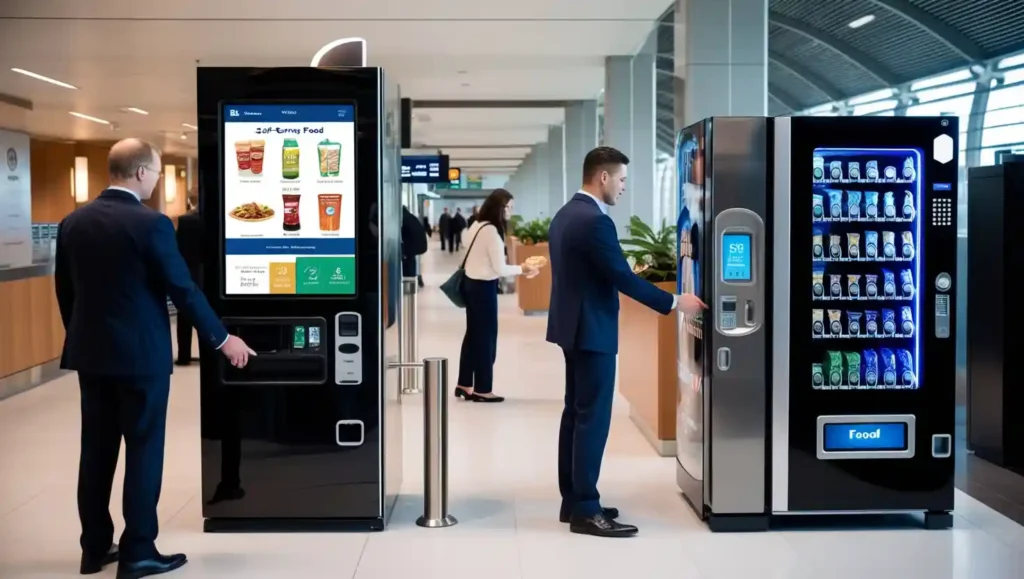
Kiosks and vending machines provide quick and convenient grab-and-go options, catering to guests who prioritise speed and efficiency. Commonly found in offices, transit hubs, and public spaces, these self-service setups focus on functionality and accessibility with minimal staff involvement.
Designed for on-the-go dining, these automated solutions ensure round-the-clock availability, making them a practical choice for busy locations.
How It Works:
- Guests select and pay for food or beverages at self-service kiosks or vending machines.
- Machines dispense pre-packaged or quick-serve items instantly.
- Some modern kiosks allow digital payments and touchscreen ordering.
Advantages:
- Operates 24/7 with minimal staffing.
- Provides a fast and efficient dining option for busy individuals.
Disadvantages:
- Limited to pre-packaged or quick-serve items.
- Cannot accommodate dietary preferences or customisations.
For insights into the design and customer flow of food courts and kiosks in modern service environments:
NRN – Innovations in Food Court and Kiosk Service
3.3 Takeaway
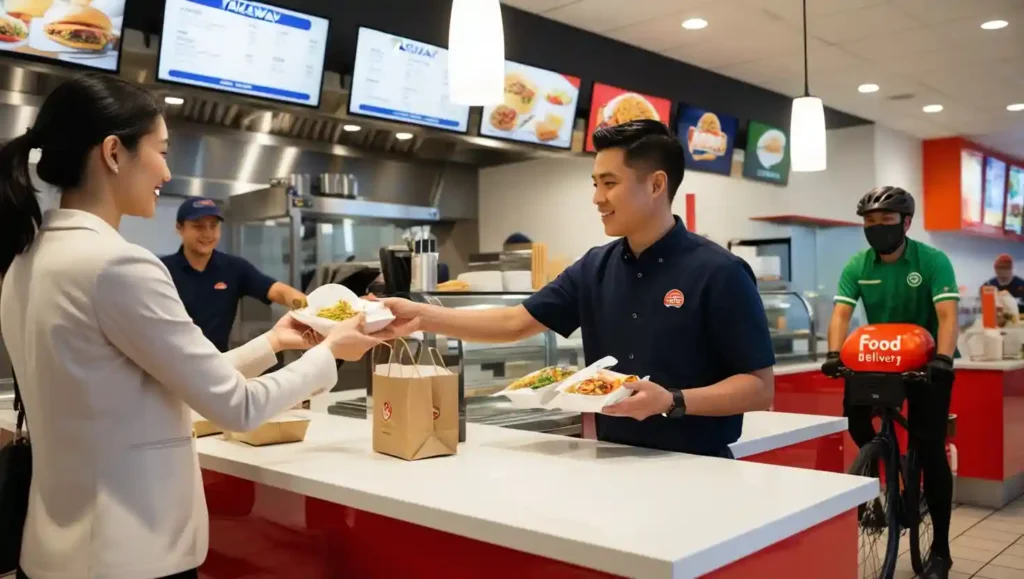
Takeaway service enables guests to order food for off-premises consumption, providing a portable and convenient dining option. Common in fast-food outlets, casual dining restaurants, and cloud kitchens, this service is increasingly paired with online ordering platforms and food delivery apps to meet modern consumer demands.
Takeaway reduces the need for large dining spaces, making it an efficient and cost-effective solution for restaurants looking to serve more customers without increasing seating capacity.
How It Works:
- Guests place orders in person, online, or via mobile apps.
- Food is packaged for easy transport and collected at the counter or delivered.
- Ensures quick service while maintaining food freshness.
Advantages:
- Convenient for busy customers who prefer off-premises dining.
- Reduces dining space needs, lowering operational costs.
Disadvantages:
- Limited interaction with guests may weaken the brand connection.
- Food quality may be affected due to transit conditions.
4. Special Service
Special Service caters to non-traditional dining settings, focusing on personalised experiences and guest convenience. This category includes room service, trolley service, and other customised dining options designed for specific situations.
These service styles are particularly popular in hotels, airlines, and healthcare facilities, ensuring comfort, accessibility, and exclusivity for guests with unique dining preferences.
Explore unique special service styles designed for specific dining needs.
4.1 Room Service

Room Service delivers meals directly to guests’ hotel rooms, providing privacy, convenience, and luxury. Orders are typically placed via phone, hotel apps, or in-room menus, and meals are served on trays or trolleys.
A signature feature of premium hospitality, room service enhances guest comfort, making it a preferred choice in hotels, resorts, and luxury accommodations.
How It Works:
- Guests place an order via phone or a digital platform.
- Staff prepare and deliver the meal to the room, often on a tray or trolley.
- Some hotels offer 24/7 room service with an extensive menu.
Advantages:
- Provides privacy and convenience for guests.
- Ideal for those who prefer in-room dining or have limited mobility.
Disadvantages:
- Requires additional staff and resources for efficient service.
- Menu options may be limited compared to on-site dining.
4.2 Tray Service

Tray Service is a compact and efficient meal delivery system commonly used in hospitals, airlines, trains, and institutional settings. It prioritises functionality and portability, ensuring meals are served in a structured and organised manner.
This service style is ideal for large-scale dining operations where quick, uniform meal distribution is essential.
How It Works:
- Meals are pre-portioned and arranged on trays for easy handling.
- Staff deliver trays to guests or patients in their respective locations.
- Used in settings requiring efficient service in confined spaces.
Advantages:
- Compact and portable, ideal for space-constrained environments.
- Efficient for serving large numbers of guests or patients.
Disadvantages:
- Limited food presentation quality compared to restaurant dining.
- Relies heavily on pre-prepared and standardised meals.
4.3 Home Delivery

Home Delivery allows guests to receive meals at their homes or workplaces, offering maximum convenience. With the rise of online food delivery platforms and mobile apps, this service has become a key component of modern dining, emphasising speed, accuracy, and accessibility.
Many restaurants, cloud kitchens, and hotels rely on third-party delivery services or in-house logistics to expand their customer reach beyond physical locations.
How It Works:
- Guests place orders online, via phone, or through mobile apps.
- Restaurants prepare and package the food for transport.
- Delivery personnel transport and hand over the meal to the customer.
Advantages:
- Provides ultimate convenience for customers.
- Expands a restaurant’s customer base beyond its physical location.
Disadvantages:
- Relies on efficient delivery networks for timely service.
- Food quality may decline due to transit conditions.
4.4 Lounge Service
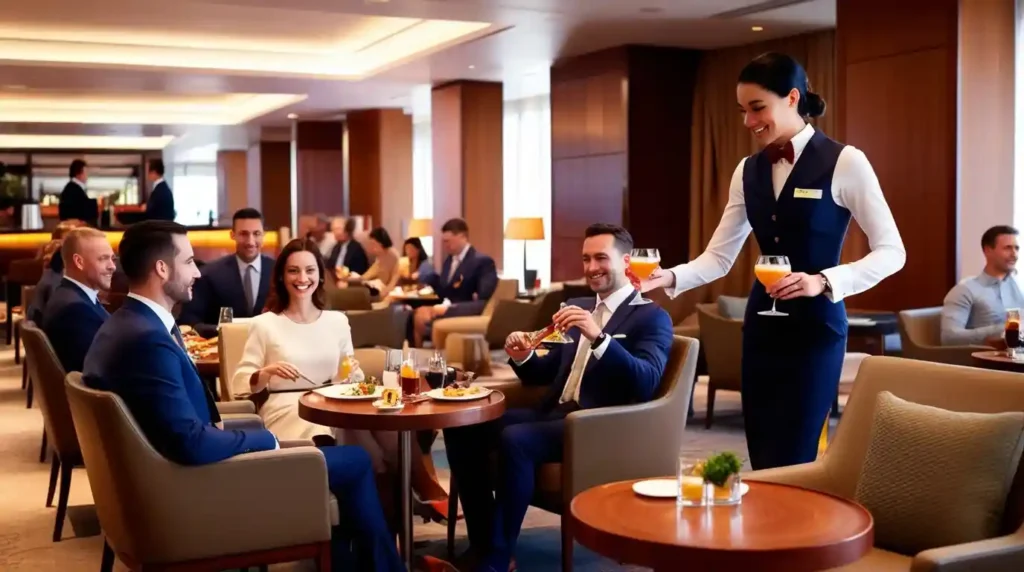
Lounge Service offers food and beverages in a relaxed, comfortable setting, commonly found in airport lounges, hotel lobbies, and VIP waiting areas. It provides a blend of casual elegance and convenience, catering to guests who prefer a laid-back yet upscale dining experience.
Menus in lounge service focus on quick snacks, beverages, and light meals, ensuring efficient service without compromising comfort.
How It Works:
- Guests order from a menu or self-serve at designated stations.
- Staff serve food and drinks to seated guests.
- Service is designed to be efficient yet refined, ideal for transit areas.
Advantages:
- Creates a luxurious and relaxed atmosphere for guests.
- Perfect for casual yet upscale dining experiences in waiting areas.
Disadvantages:
- It may not be suitable for high-volume or budget-conscious operations.
- Requires frequent monitoring to maintain cleanliness and ambience.
4.5 Grill Room Service

Grill Room Service offers an interactive dining experience where guests select raw ingredients such as meats, seafood, or vegetables, which are then grilled to order by a chef. This ensures freshness, customization, and an engaging culinary experience.
This style is popular in steakhouses, barbecue restaurants, and high-end hotel grill rooms, where guests appreciate watching their meals being prepared.
How It Works:
- Guests choose raw ingredients from a display counter or menu.
- A chef grills the selection to the guest’s preferred doneness.
- The cooked meal is plated and served directly to the guest.
Advantages:
- Ensures freshly prepared meals with customised cooking preferences.
- Enhances guest engagement with an interactive dining element.
Disadvantages:
- Requires specialised kitchen equipment and trained staff.
- Longer preparation times may slow service for larger groups.
Conclusion
The various types of food and beverage service play a crucial role in shaping the dining experience, catering to different settings, customer preferences, and operational goals. Whether it’s the elegance of table service, the efficiency of self-service, or the flexibility of assisted and special services, each style offers unique benefits to both guests and establishments.
By understanding these service types, restaurants, hotels, and hospitality businesses can choose the most suitable approach to enhance customer satisfaction, optimise efficiency, and create seamless, memorable dining experiences
Related Articles:
- Complete Guide to Different Types of Glassware in Food & Beverage Service
- Waiter/Waitress Job Description: Duties, Responsibilities, and Essential Skills
- Types of Food and Beverage Outlets: A Guide for Hospitality Professionals
- Sequence of Service in Restaurants: Steps of Table Service in Fine Dining
- Types of Bars: A Complete Guide for Hospitality Professionals
This article was written by Saswata Banerjee, the creator of Food and Beverage Service Knowledge, based on 8+ years of experience in the hospitality industry.


